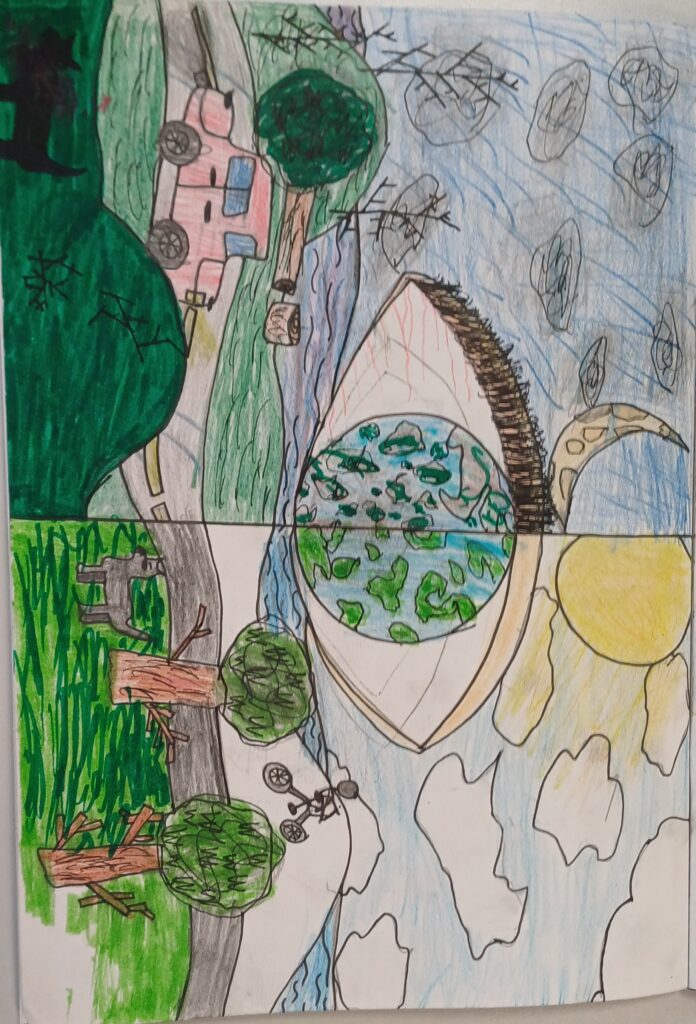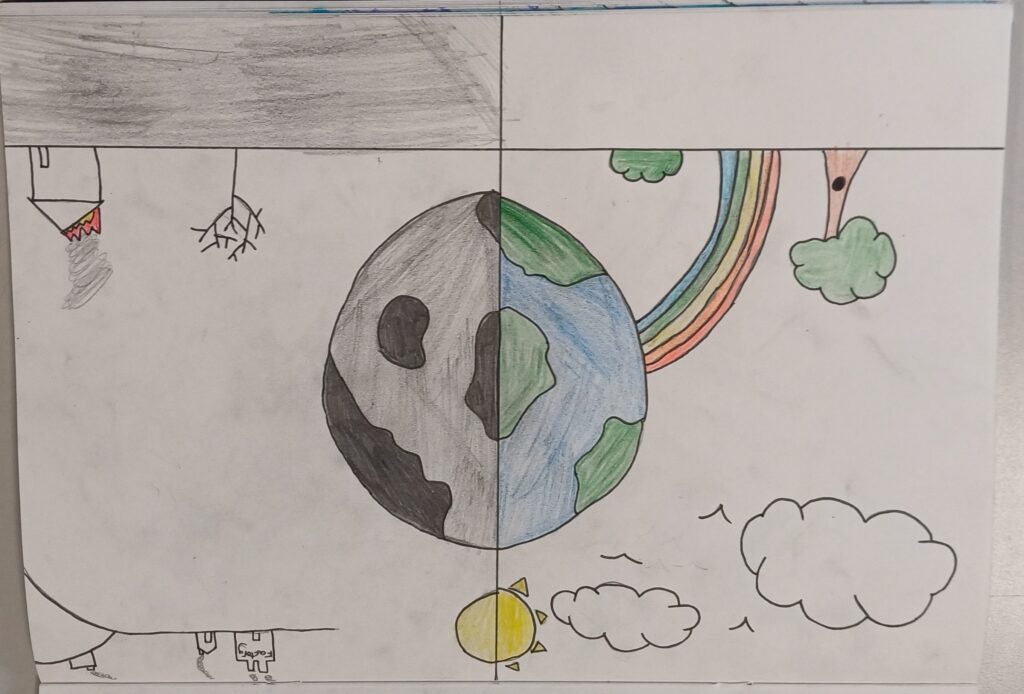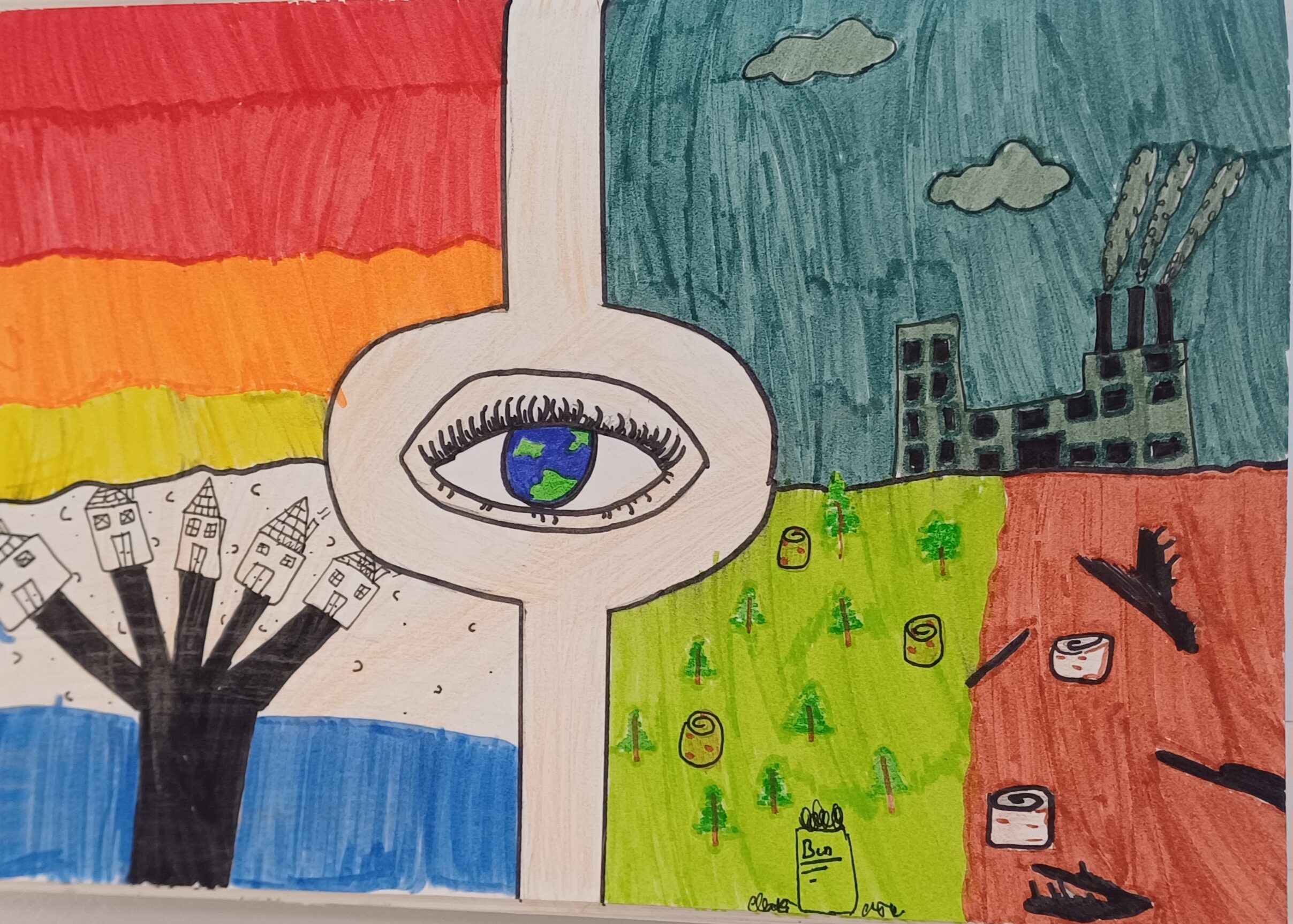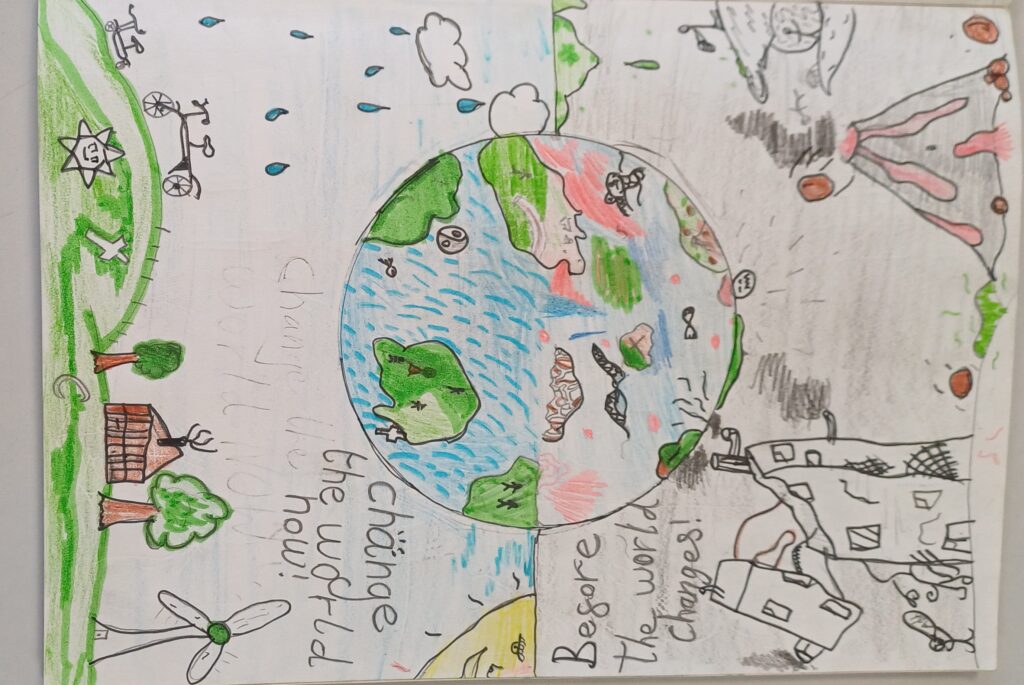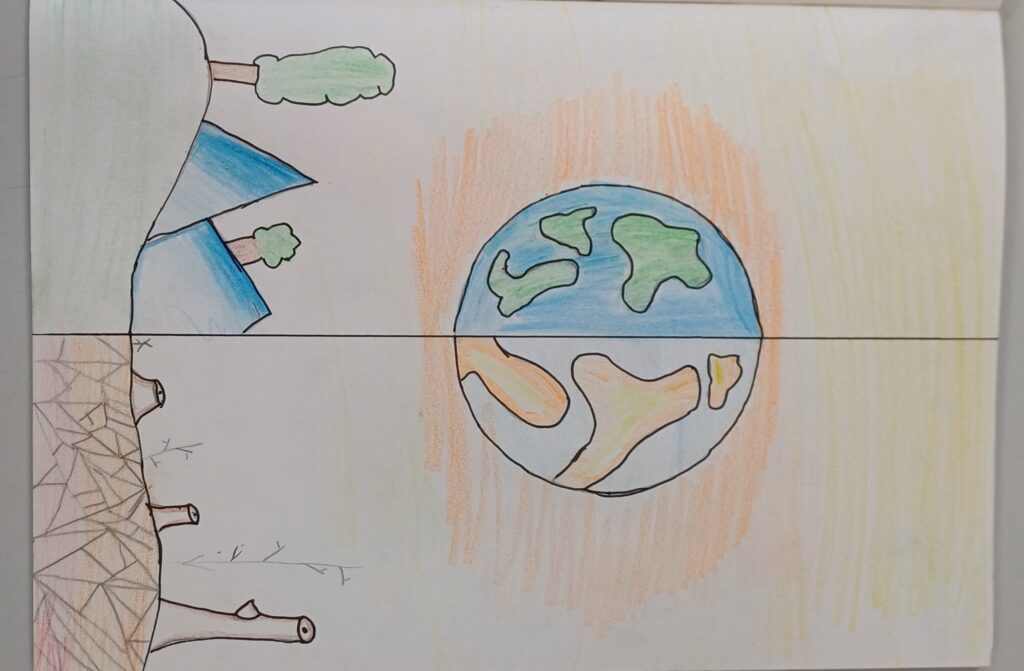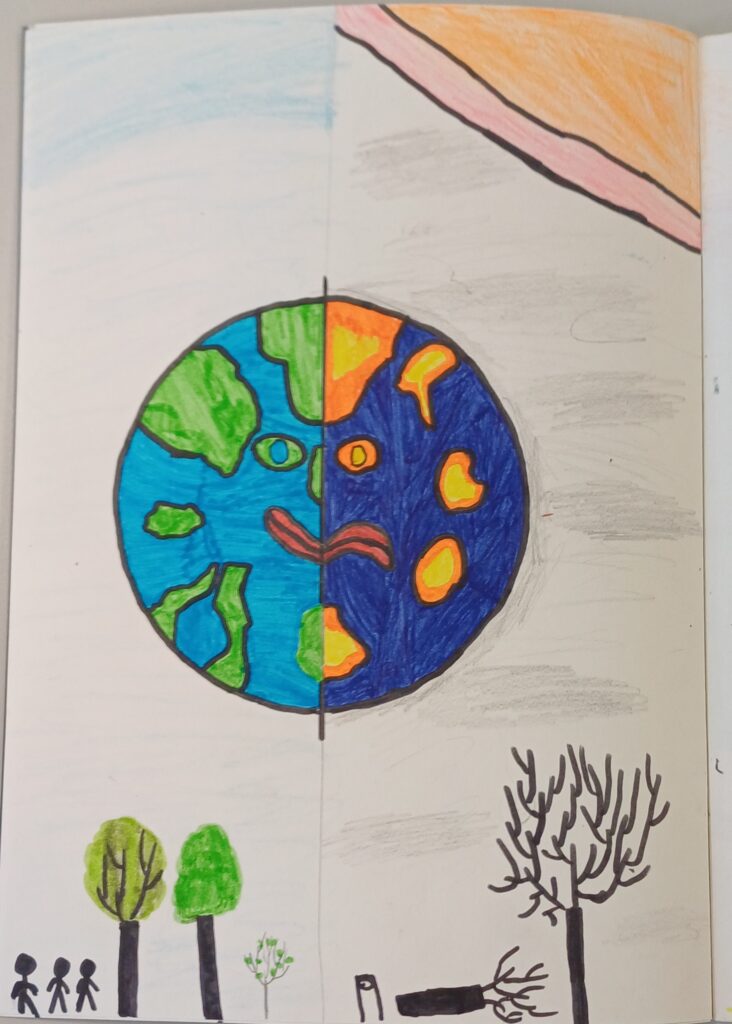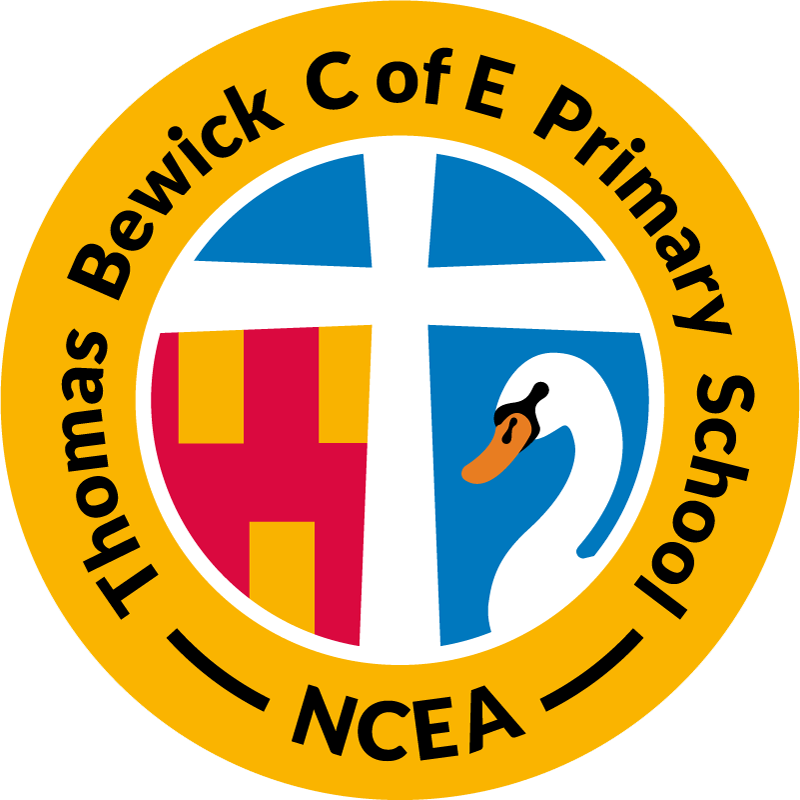Spirited Arts: ‘Stories That Change Lives’…
This term, the children at Thomas Bewick Primary School have taken part in the national Spirited Arts competition, organised by NATRE (The National Association of Teachers of Religious Education). The theme chosen by the school was ‘Stories That Change Lives’, inspiring pupils to explore how stories from different religions – both ancient and modern – can still have a powerful impact on people’s lives today.
Each year group selected a different religious story linked to the theme. These stories came from a variety of faiths, including Christianity and Sikhism. The children discussed the messages behind the stories and how they could influence the way we treat others, understand the world, or make personal choices.
Using their creativity, the children expressed these ideas through colourful and thoughtful artwork. Some created paintings, while others used collage, sculpture, or digital art. Each piece aimed to show how the message of a particular story could inspire kindness, courage, forgiveness, or hope in the modern world.
Teachers and staff were incredibly proud of the effort, imagination, and reflection shown by the children. The artwork is currently being displayed around the school, and some entries have even been submitted to the national Spirited Arts gallery.
Well done to all the pupils for their hard work and thoughtful contributions!
Year 1 – Jonah and the Whale
2. Stories that changed lives: Jonah and the Whale
As part of our recent art project, we created a vibrant and imaginative piece of artwork inspired by the biblical story of Jonah and the Whale. This activity beautifully combined storytelling and art, allowing the children to express their understanding of the narrative through visual art.
We began by reading the story and then carefully thought about which image we wanted to portray. We designed this in our art books, thinking carefully about how to represent different elements of the story. We discussed the key moments in Jonah’s journey, with a particular focus on his time inside the whale, and how we could translate that visually.
For the actual artwork, we used bubble wrap to demonstrate and develop our printing skills, which the children found very exciting! Paint was applied to the bubble wrap and then pressed onto squared polystyrene boards, producing an appealing textured effect that mimicked the dynamic nature of the sea. The background chosen for the artwork was a night sky filled with a glowing moon and twinkling stars, setting the scene where the whale swims through the vast ocean. This starry sky gave the piece a magical and reflective quality, capturing the wonder of the story.
Many children chose to depict Jonah inside the whale, and some thoughtfully added a candle beside him. The candle was used to symbolize “the light of the world.” The use of printing allowed the children to explore pattern, repetition and texture, while the planning and design process helped develop their ability to visualize and compose an image.
The resulting artworks were full of personality, with each piece telling its own version of Jonah’s journey. Not only did the children develop important artistic skills, but they also gained a deeper understanding of the story’s message of faith, forgiveness, and light in dark places. Displayed together, the finished prints created a striking painting that celebrates both creativity and storytelling, and it was wonderful to see how confidently and thoughtfully the children approached the entire project.
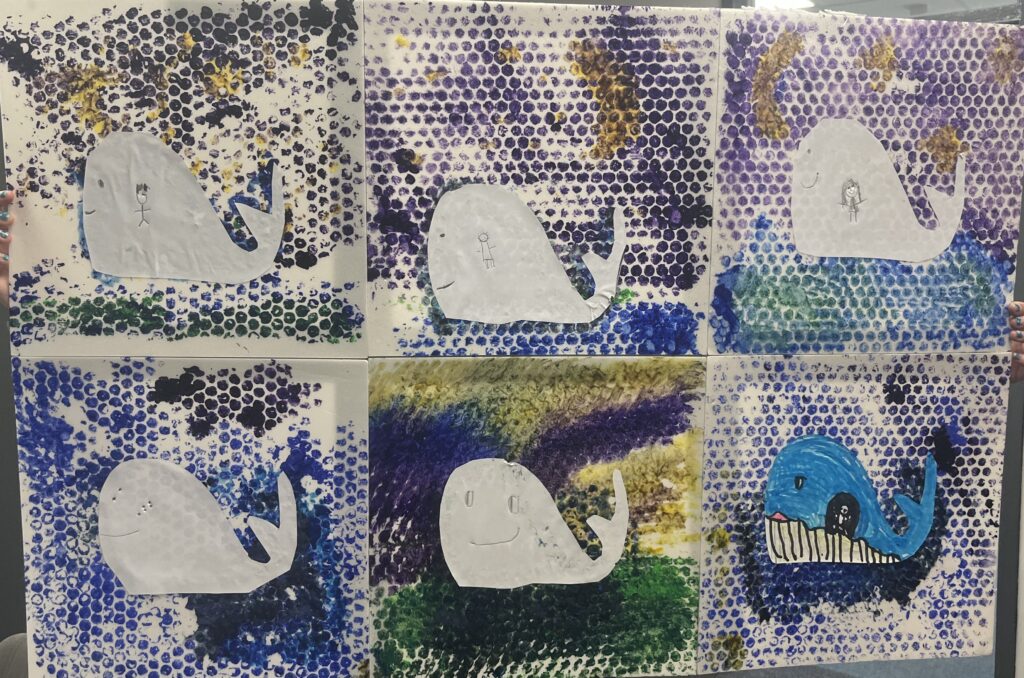
Year 2 – The Story of Jesus
In year 2, we created our own stained-glass window based on the Bible story of Jesus feeding the 5,000. Using coloured paper, black card for the frames, and careful cutting and layering techniques, we designed individual panels that we then combined to make one large collaborative stained-glass window. This process allowed us to reflect not only on the miracle itself but also on how we can express spiritual messages through art.
The story of Jesus feeding the 5,000, found in all four Gospels, tells of a time when Jesus was followed by a large crowd. Moved with compassion, He took five loaves of bread and two small fish offered by a young boy and miraculously multiplied them to feed everyone present, with twelve baskets of leftovers. Our stained-glass window captured this moment with images of Jesus blessing the food, the boy offering his meal, and crowds seated on a grassy hillside. We used soft blues and greens for the landscape and water, with warmer colours like reds, golds, and oranges to represent the miracle and the love shared that day.
This story links powerfully with the Bible verse 1 Corinthians 16:14, which says, “Let all that you do be done in love.” Jesus’ actions in this miracle were motivated by love for the people—He saw their needs and responded with kindness, generosity, and care. In the same way, we were inspired to put love and care into our artwork, working together as a team and sharing our ideas to create something beautiful and meaningful. Each piece of our stained-glass window was like the loaves and fish—small on its own, but together, something greater was achieved.
By using simple materials like paper, our project reminded us that even ordinary things can become extraordinary when we act with love. The finished stained glass window is not only a piece of art but also a daily reminder of Jesus’ love, the importance of sharing, and how we can each play a part in bringing light and hope to others.
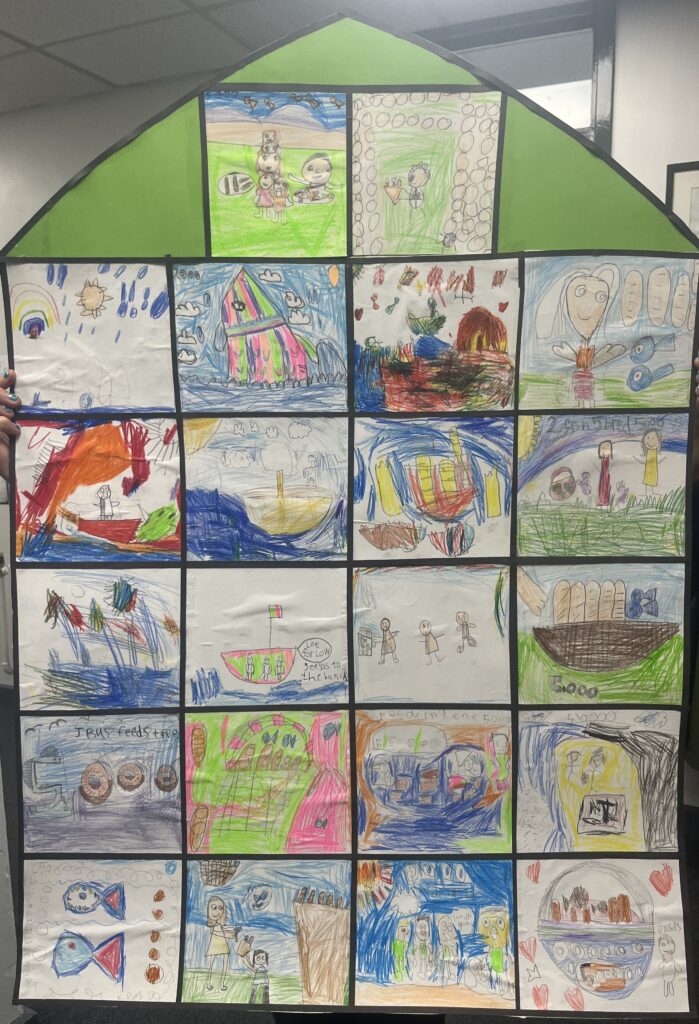
Year 3 – Our School Vision: “Let all that you do be done in love” – 1 Corinthians 16:14
As a class, we took inspiration from our school vision and explored how people throughout history have lived out this Bible verse. One such individual was William Booth, a significant religious leader, social reformer, and humanitarian. He founded The Salvation Army.
Year 3 learnt about the serious issues faced by workers in match factories during the late 19th century. Matches were manufactured by young girls—known as the match girls—at the Bryant and May factory in East London. Many of them were teenagers, working long hours in hazardous conditions for very low pay. Worst of all, they were exposed to white phosphorus, which caused “phossy jaw”—a painful, disfiguring, and often fatal disease that rotted the jawbone.
In 1888, the match girls courageously went on strike to protest against their treatment. Booth, already deeply committed to helping the poor, was moved by their bravery and the injustice they endured.
He firmly believed that spiritual support meant little if people were starving or suffering. As Booth once said, “You cannot warm the hearts of people with God’s love if they have empty stomachs and cold feet.” Inspired to take action, he established a match factory run by The Salvation Army. This factory used safe red phosphorus and paid fair wages, proving that ethical business was not only possible but effective.
This initiative became part of Booth’s broader “Darkest England” campaign—a mission to bring hope to those trapped in poverty, addiction, and despair. His slogan, “Strike a light for Darkest England,” was a clever play on words, referring both to lighting a match and to sparking change against social injustice.
William Booth’s support for the match girls stands as a powerful example of Christian faith in action. He did not merely preach kindness—he lived it. His compassionate response helped shift public attitudes and improve working conditions, demonstrating how empathy and courage can bring light to the darkest of times.
The children remind us that even a small spark of justice can illuminate the path forward. We learnt so much from exploring how one person’s actions can inspire real change. The class worked together to translate this message into a creative project: a large class banner. They designed and cut out templates of flames and words, which were traced onto felt and used to create matchstick shapes. These “lit matches” surround Booth’s inspiring slogan, symbolising the impact of love in action.
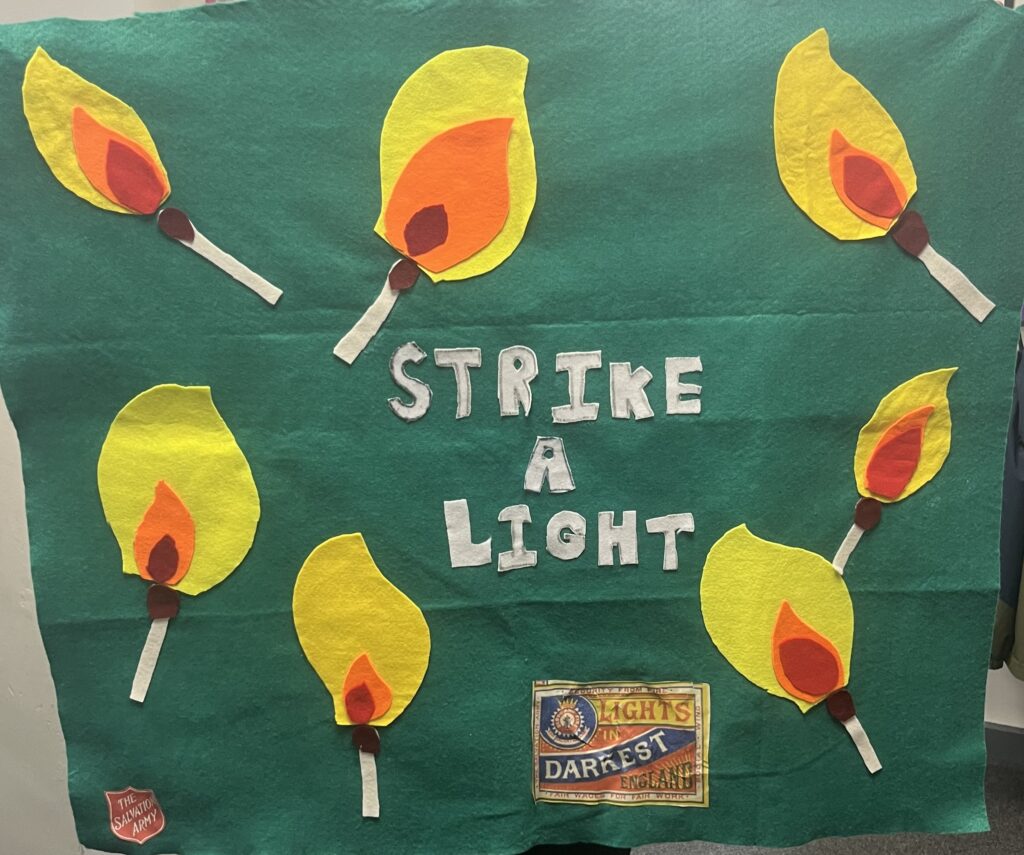
Year 4 – The Story of Guru Nanak and the Boulder
Guru Nanak once stayed near a hillside where a man named Wali Kandhari lived. Wali had control over the only spring of water in the area. When Guru Nanak began helping people and teaching them to share and be kind, Wali grew jealous. To punish the people, Wali stopped the water. Guru Nanak calmly moved a small stone nearby, and a fresh spring of water began to flow! Wali became angry and rolled a huge boulder toward him. But Guru Nanak stopped it with his hand—his handprint stayed on the rock. Wali then understood the power of kindness and sharing.
When learning about Sikhism the children really enjoyed the story of Guru Nanak and the Boulder, so we decided to revisit this for our art work. Firstly, we looked further into the feelings of each character in the story. We found that the man who pushed the boulder was displaying jealousy, greed and anger. We then turned to the villagers and Guru Nanak to explore the feelings and qualities they would have to possess as the story was told. The children came up with the words humility, kindness, forgiveness and want and need.
One of the main parts of the story we focused in on was the boulder and what this represented. The children discussed how it prevented sadness, it was a strong force and also faith. Guru Nanak had faith that he would be able to stop the unpleasantness and greed.
Therefore, when we created the piece of shared art work we wanted to represent the boulder in the centre as clay, as we found it was the most critical part of the story. On the clay, we picked words to carved in just like the handprint imprinted onto the boulder. Each child designed their own hand and colours to represent the feelings and the water flowing. We took from each child’s art work to create a shared mosaic background. There are flowers to represent new beginnings and forgiveness. The water is flowing freely through the hand to represent feelings flowing over you.
When the children created this art work, each student had a turn of creating the mosaic to show unity and team work. They drew round a child’s hand and spread the fingers to show strength. Together they have a made a beautiful piece of artwork to represent this story.
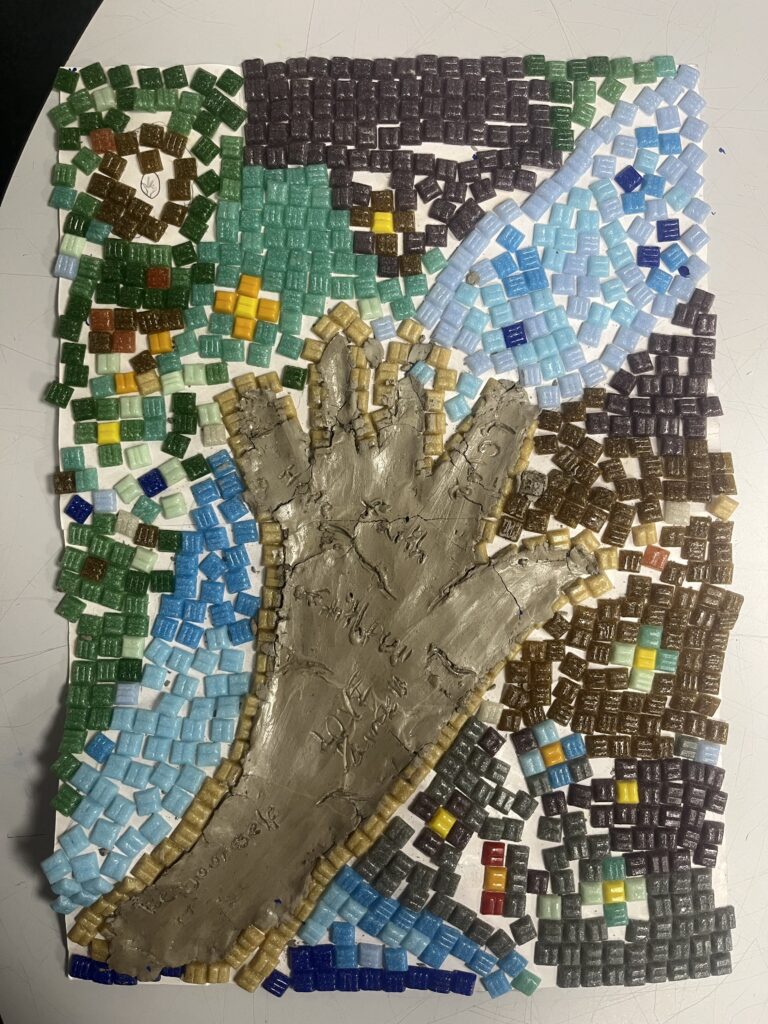
Year 5 – Symbolism Through Storytelling Art
A striking piece of digital artwork created by a Year Five class captures both creativity and deep spiritual reflection through the medium of photography. At first glance, the image presents a simple composition: a plate filled with vibrant red liquid, symbolising the blood of Jesus, sits beneath an inverted glass containing a lit candle.
As the candle burns, it creates a vacuum that draws the red liquid up into the glass — a deliberate and symbolic representation of Jesus absorbing the sins of the world when He died on the cross. The red liquid, rising into the transparent vessel, evokes a powerful visual metaphor of sacrifice, purification, and redemption. The lit candle itself represents the light of Christ, illuminating the darkness and guiding believers. Surrounding the central image is a background collage made up of the children’s own hand-drawn pictures and carefully chosen words.
Each illustration depicts sin in various forms — from unkindness to dishonesty. Interspersed among these are words and names associated with Jesus, such as “kindness,” “loving,” and “Forgiveness,” serving as a contrast and pointing toward hope, grace, and salvation. The juxtaposition of dark themes with hopeful imagery and language highlights the central Christian belief that Jesus took on the world’s sins to offer a path to redemption.
The project also gave the children the opportunity to explore symbolism and storytelling through art, developing their creative thinking alongside their spiritual understanding. Their collaborative effort resulted in a moving and thoughtful piece that goes beyond simple religious illustration, instead inviting viewers of all ages to reflect on the nature of sin and the profound gift of grace.
The choice of everyday objects — a plate, a candle, a glass — grounds the message in the real world, making it relatable and memorable. Altogether, this photograph is not only a testimony to the children’s artistic abilities but also a heartfelt expression of their faith and learning. Through digital art, the Year Five class has crafted a visual sermon that speaks quietly but powerfully about sacrifice, love, and hope.
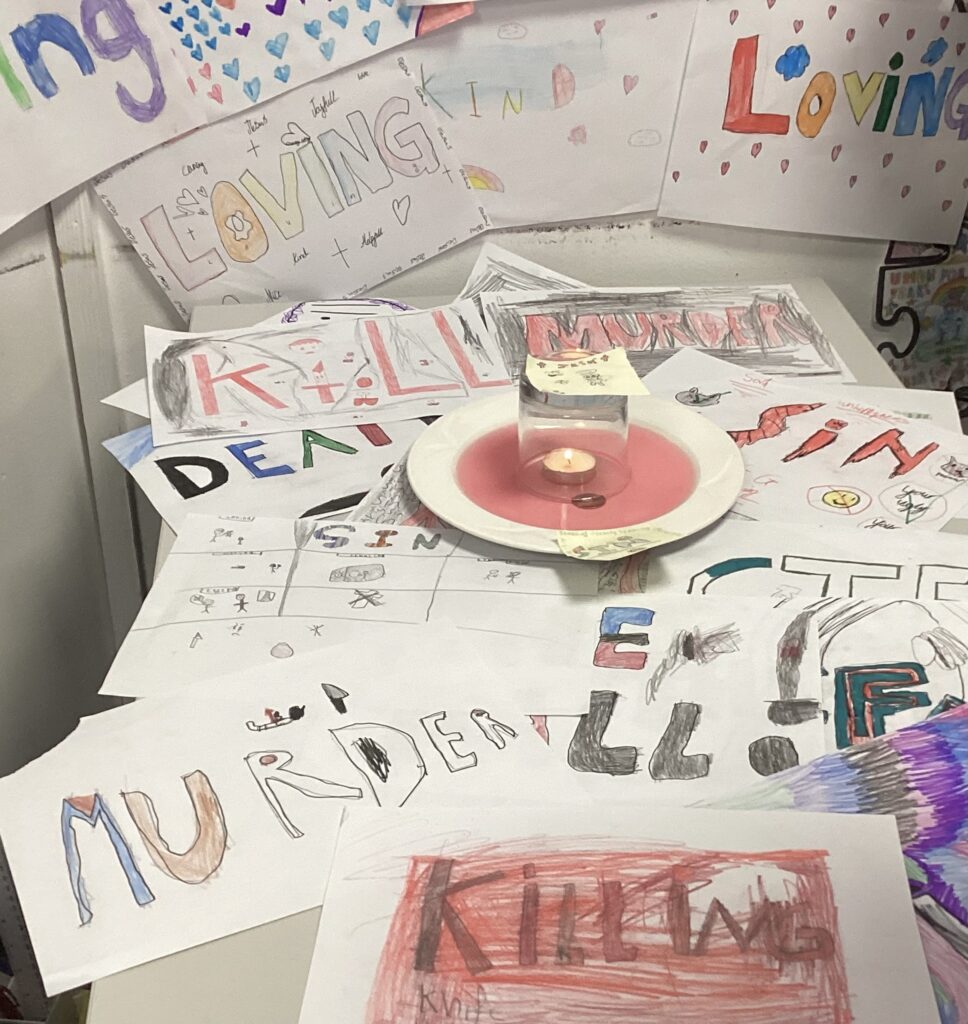
Year 6 – Creation Verses Humanity
The Year 6 children at Thomas Bewick Primary have been thinking about the Christian creation story as described in the Book of Genesis. Their pictures show God creating the world in seven days, beginning with light and darkness, followed by the sky, land, sea, plants, animals, and finally, people—Adam and Eve. Bright colours and simple shapes reflect the wonder and imagination children bring to the story. The sun, moon, stars, animals, and lush gardens often feature prominently, representing the beauty and order of God’s creation. Through their drawings, children express both the sequence of creation and their understanding of a loving God who made the world with care and purpose.
Some children went on to portray through art how humans have had a negative impact on God’s creation of the world. Inspired by the Christian belief that God made the Earth good and beautiful, the artwork contrasts this original harmony with scenes of pollution, deforestation, and endangered animals. Some children chose to depict factories with smoke, littered oceans, or trees being cut down, showing their understanding of how human actions can damage the environment God entrusted to us. Through their drawings, they express concern, sadness, and a desire to care for the Earth, highlighting the importance of caring for humanity and reminding us of our responsibility to protect God’s creation.
Our Year 6 children have really enjoyed taking part in this competition that links art with spirituality, as it gave them a creative way to express their thoughts and feelings about faith and the world around them. They found it exciting to explore deep ideas—such as creation, care for the Earth, and their connection with God—through drawing, painting, and other artistic forms. Many said it helped them think more deeply about spiritual topics and allowed them to show their beliefs and values in a personal and meaningful way. The competition also gave them a sense of pride and confidence, as they shared their artwork with others and saw how everyone’s ideas were unique but equally special.
